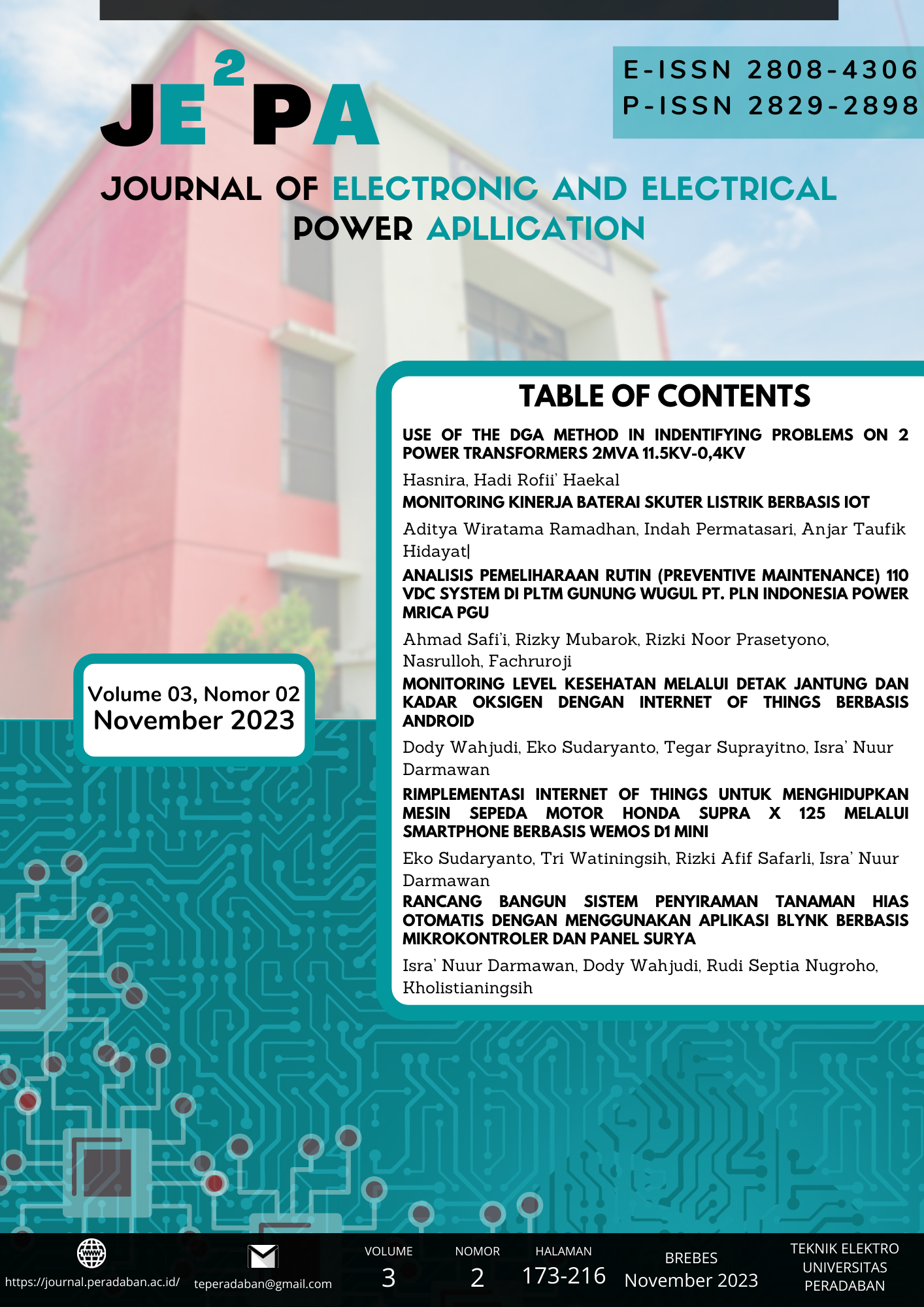DESIGN OF AN AUTOMATIC DECORATIVE PLANTS WATERING SYSTEM USING THE BLYNK APPLICATION BASED ON MICROCONTROLLER AND SOLAR PANEL
DOI:
https://doi.org/10.58436/jeepa.v3i2.1666Keywords:
Blynk, Plant, Smartphone, Sprinkling, WemosAbstract
Just like humans, plants need water for their growth and development. Plants should not have a lack or excess of water, soil that lacks water makes plants develop slowly and in ornamental plants makes the plants look not fresh and wilted and vice versa, plants that have too much water also make the plants unhealthy and can even cause the plants to die. The aim of the research is to design and build an automatic plant watering device that can be controlled remotely via an Android smartphone application, to determine the response speed of the tool in executing commands given by the user via the Android application, to find out the benefits of solar panels in order to save electricity usage in watering. Ornamental Plants by determining tool needs from various literature and collecting data from internet references and books as well as data that is needed and analyzing the components needed to make tools. The results of the research produced points, namely success in designing an automatic plant watering device based on the Wemos D1 R1 Microcontroller with the Blynk Application on Android as a remote control, the results of the characterization of the type of sensor used, namely the Soil sensor. Senor Soil has an accuracy of 98.65% and a standard deviation of ±0.14 for air temperature measurements and an accuracy of 98.72% and a standard deviation of ±0.38 for air humidity readings, the updated data on the Blynk Application is in accordance with the data sent by the Wemos D1 R1 Microcontroller. There is a time difference of 1 second between the data transmission time by the Wemos D1 R1 Microcontroller and the data reception time by the Blynk Application. The automatic plant watering tool that has been designed has a response speed of 2 seconds, starting from the time the user gives the command via the Blynk Application on the Smartphone until the device start the watering process
References
[[1] Matondang, Christina Oktora, and N. Nurhayati. "Pengaruh Cekaman Air Terhadap Pertumbuhan dan Produksi Tanaman Kopi." BEST Journal (Biology Education, Sains and Technology) 5.1 (2022): 249-254.
Nugroho, Christian Ardianto, and Andree Wijaya Setiawan. "Pengaruh Frekuensi Penyiraman dan Volume Air terhadap Pertumbuhan Tanaman Sawi Pakcoy Pada Media Tanam Campuran Arang Sekam dan Pupuk Kandang." AGRIUM: Jurnal Ilmu Pertanian 25.1 (2022): 12-23.
Rusmayadi, Gusti, et al. "Evaluasi Efisiensi Penggunaan Sumber Daya Air dalam Irigasi Pertanian: Studi Kasus di Wilayah Kabupaten Cianjur." Jurnal Geosains West Science 1.02 (2023): 112-118.
Utami, Dyah Nursita, et al. "Karakteristik Kapasitas Penyimpan Air dan Efisiensi Penyimpanan Air Media Tumbuh Penahan Erosi ‘Biotextile’." Berkala Ilmiah Biologi 14.1 (2023).
Sari, M., & Bangun, R. Rancang Bangun Alat Penyiram Tanaman Otomatis Menggunakan Sensor Kelembaban Tanah. In Cetak) Journal of Electrical Technology (Vol. 3, Issue 1), 2018.
Kaikatui, Rapha Nichita, Nurfitri Nurfitri, and Rivaldo Corputty. "Penyiraman Tanaman Otomatis Berbasis Mikrokontroler Arduino Uno." Musamus Journal of Electro & Mechanical Engineering 5.02 (2023): 9-14..
Wulandari, P. A., Rahima, P., & Hadi, S. Rancang Bangun Sistem Penyiraman Otomatis Berbasis Internet of Things Pada Tanaman Hias Sirih Gading. Jurnal Bumigora Information Technology (BITe), 2(2), 77–85, 2020. https://doi.org/10.30812/bite.v2i2.886
Nipu, Lidia Paskalia. "Penentuan Kualitas Air Tanah sebagai Air Minum dengan Metode Indeks Pencemaran." Magnetic: Research Journal Of Physics and It’s Application 2.1 (2022): 106-111.
Macheso, Paul SB, et al. "Environmental parameter monitoring system based on nodemcu esp8266, mqtt and node-red." 2022 International Conference on Computer Communication and Informatics (ICCCI). IEEE, 2022.
Hamdani, Muhammad Nauval Khoiron, Indah Sulistiyowati, and Shazana Dhiya Ayuni. "Automatic Stove Control System Based on the NodeMCU ESP8266 Microcontroller." Journal of Electrical Technology UMY 6.2 (2022): 103-111.
Deab, Mustafa Yassin, and Muayad Sadik Croock. "Smarter dam based on cyber-physical system utilizing Raspberry Pi4 and NodeMCU ESP8266." Bulletin of Electrical Engineering and Informatics 11.6 (2022): 3403-3413.
Muhammad, Saiful Azhari, and Haryono Haryono. "Design of Pond Water Temperature Monitoring Built Using NodeMCU ESP8266." Sinkron: jurnal dan penelitian teknik informatika 7.2 (2022): 579-585.
Hidayat, Rahmat. "Sistem Monitoring Air Qualty (Si Montoq) Menggunakan Sensor Mics-6814 dan DHT-11 Berbasis Internet of Things." Jurnal Komputer dan Elektro Sains 2.1 (2024): 6-9.
Indu, A., and S. Magesh Kumar. "An Approach for Implementing Innovative Weather Monitoring System with DHT11 Sensor and Arduino Uno Tool based on IoT." 2022 Sixth International Conference on I-SMAC (IoT in Social, Mobile, Analytics and Cloud)(I-SMAC). IEEE, 2022.
Hadi, Sirojul, Radimas Putra Muhammad Davi Labib, and Parama Diptya Widayaka. "Perbandingan Akurasi Pengukuran Sensor LM35 dan Sensor DHT11 untuk Monitoring Suhu Berbasis Internet of Things." STRING (Satuan Tulisan Riset dan Inovasi Teknologi) 6.3 (2022): 269-278.
Jenila, R., C. Kanmani Pappa, and C. Supraja. "A Smart and Precision Agriculture System Using DHT11 Plus FPGA." Machine Learning and Autonomous Systems: Proceedings of ICMLAS 2021. Singapore: Springer Nature Singapore, 2022. 579-589.
Bazani Shaik, Dr M., P. Siddik Ali, and K. Bhavanarayana. "Design and Development Of Automatic Sanitization and Temperature Measuring System." System 11.09: 281-287.
Tembhurne, Vicky, Mukesh Bhatkar, and Yogesh Ikhe. "Automatic Greenhouse Environment Monitoring and Controlling System." International Journal of Research in Engineering, Science and Management 5.12 (2022): 30-33.
Islam, Mohammad Samunul, and Golap Kanti Dey. "Precision agriculture: renewable energy based smart crop field monitoring and management system using WSN via IoT." 2019 International Conference on Sustainable Technologies for Industry 4.0 (STI). IEEE, 2019.
Khillare, Shubham R., et al. "A Review of Fully Automated Grass Cutter Using Solar Power." International Journal of Research in Engineering, Science and Management 3.7 (2020): 108-111.
Adam, Tijjani, et al. "Nano humidity and temperature sensors activated water pump agricultural system." AIP Conference Proceedings. Vol. 2339. No. 1. AIP Publishing, 2021.
Prihatini, Ekawati, et al. "Pemanfaatan Sensor Jarak dan Sensor Warna pada Proses Penanaman Benih Menggunakan Smart Mini Robot Agriculture." TEKNIKA 15.1 (2021): 143-151.
J. M. S. Waworundeng, N. C. Suseno, and R. R. Y. Manaha, “Perancangan Alat Penyiram Tanaman Otomatis berbasis Sensor dan Mikrokontroler,” no. November, p. ISSN : 2598-4969, 2017.
Purwoto, Bambang Hari, et al. "Efisiensi penggunaan panel surya sebagai sumber energi alternatif." Emitor: Jurnal Teknik Elektro 18.1 (2018): 10-14.
J. L. Hatfield and J. H. Prueger, “Temperature extremes: Effect on plant growth and development,” Weather Clim. Extrem., vol. 10, pp. 4–10, 2015, doi: 10.1016/j.wace.2015.08.001
D. Rahmawati, F. Herawati, and G. Saputra, “Karakterisasi Sensor Kelembaban Tanah ( YL-69 ) Untuk Otomatisasi Penyiraman Tanaman Berbasis Arduino Uno,” pp. 92–97.
Hawa, S. D., Syauqi, A., Rolisnawati, R., & Za'im Akbar, H. (2023). Factor Analysis of Demand for Kaligua Tourism in Brebes Regency: A Case Study Using Primary Data. Media Trend, 18(1), 90-101.
Al Banin, Q., Eliyana, A., & Latifiyah, E. R. (2020). Enhancing employee performance with work motivation as a mediation variable. Systematic Reviews in Pharmacy, 11(9), 333-346.










